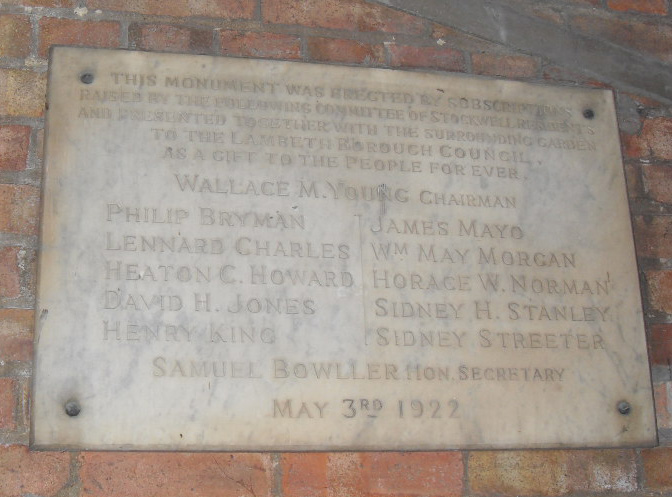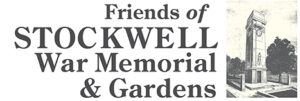Listed Building status Designed by Frank T Dear in 1920, unveiled 3rd May 1922 by Princess Alice Countess of Athlone. Neo Grecian style. Tower on plinth 45 feet high of portland stone, and altered towards base. Front has relief figure of Remembrance, in Greek mourning dress with inscription “To the Stockwell men who served in […]
Frank T. Dear and Benjamin Clemens
Frank T. Dear A virtually unknown local architect, Frank T. Dear, won the competition for Stockwell War Memorial. The design was selected by the Royal Academy War Memorials Committee and, according to the report in The Builder (26 March 1920, p 356), was the clear favourite. The Builder also approved the design, commenting that the […]
Stockwell War Memorial committee
The memorial houses a marble plaque commemorating the committee who raised – by public subscription – the considerable for the building of the memorial. It reads: This monument was erected by subscriptions raised by the following committee of Stockwell residents and presented together with the surrounding garden to the Lambeth Borough Council, as a gift […]
1922: A poem written for the unveiling of Stockwell War Memorial
South London Press 11 May 1922 Stockwell’s Heroes (Lines written in the garden of the Memorial Clock Tower unveiled last week) Let all who seek this garden fair A thought for Stockwell’s heroes spare, The gallant lads who trod the road Of sacrifice and bore the load Of suffering for you and me And generations […]
1922: Stockwell’s heroic dead
This report of the unveiling and dedication was published in the Brixton Free Press on 5 May 1922 STOCKWELL’S HEROIC DEAD. Royal Unveiling of Imposing Monument. One of the Finest of London’s War Memorials. That which, in its genesis, was to have been a worthy memorial to the brave men of Stockwell who made the […]
1922: Stockwell War Memorial unveiling: the dramatic ceremony
Although the language is old-fashioned, this front-page report in the South London Press conveys something of the emotions of loss, regret and pride the local community felt in the years after the end of the war. The details – the women carrying “wreaths or little bunches of flowers, according to circumstances” – carry a poignancy […]
1922: Stockwell War Memorial unveiling – an appeal
This account was published in the South London Press shortly before the opening of the Stockwell War Memorial in May 1922. 28 April 1922 STOCKWELL MEMORIAL. Arrangements for Unveilling and Dedication of Princess Alice (Countess of Athlone). NEXT WEDNESDAY’S CEREMONY. The Stockwell War Memorial, which has beeen erected at the junction of South Lambeth and […]
1922: Dr. Foord Caiger gives the clock in memory of his only child
Dr. Foord Caiger, whose son Frederick Caiger died on 11 November 1916, donated the clock on the memorial tower. The following report appeared in the South London Press on 22 February 1922 SOUTH LONDON PRESS 22 February 1922 A DOCTOR’S GIFT TO STOCKWELL. War Memorial Clock Presented by Father of a Fallen Hero. TRIBUTE TO […]
1921: Metropolitan Police assist the fund-raising effort
On 1 July 1921 the South London Press reported on a recent fund-raising during which they presented a minstrel show. Much frowned on now, at that time, minstrels shows, in which performers appeared in evening dress and blackface and sang negro spirituals and popular ballads, were regarded as perfectly acceptable forms of entertainment. The Police […]
1921: “Uncalled-for Statements”
The efforts to build a memorial to the men of Stockwell and surrounding areas who lost their lives in the First World War started soon after the war ended, and Stockwell was praised for its energy and decisiveness in opting for a publicly-funded monument that would be handed to Lambeth Borough Council for upkeep. However, […]


